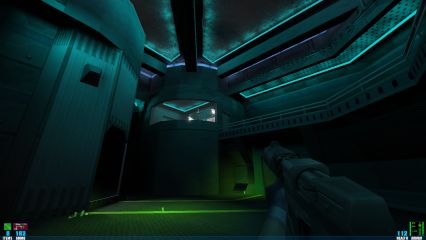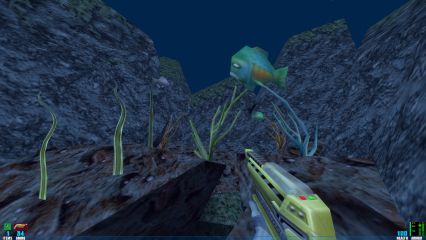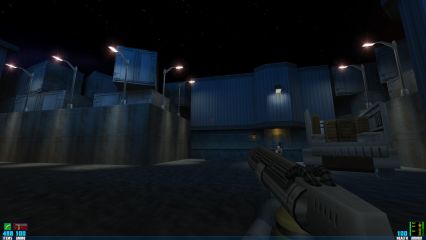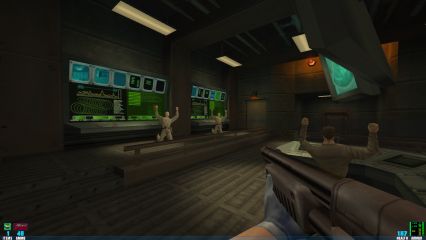11th of January 2019
Sin
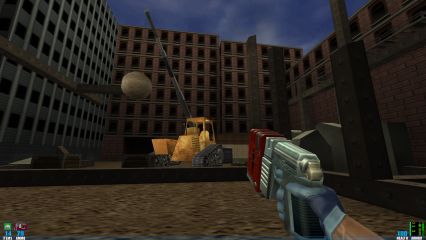
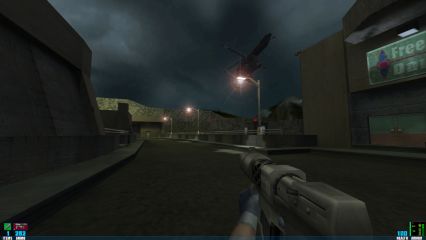
Note: The GOG version is bundled with the Wages of Sin mission pack. On Steam you need to purchase Sin Episodes: Emergence to get the 1998 game, but the mission pack is not included. You need patches for wide-screen support and to disable mouse acceleration.
Sin was dead on arrival; released in late 1998 buggy as hell, the common wisdom at the time had it that Activision had rushed the game out so that it wouldn't have to compete with Half-Life. It wasn't the lukewarm reviews that destroyed it (the game never had the kind of overwhelmingly negative critical reception that, say, Daikatana had); it was word-of-mouth. I personally experienced the hell Sin was in the weeks following the release; while I got Half-Life for Christmas, my friend got Sin (and this was in the pre-DRM era when it was still relatively easy to install the same copy on multiple machines). The map loading times could be as high five minutes and there was intense stuttering; the very opening helicopter sequence was a stuttering mess that only Polymer could rival more than a decade later, and some of the maps involving trial and error were pure agony because of the long loading times. There were plenty of other issues too, including game-breaking bugs. A patch was later released, but it was around 20 megabytes; on a dial-up it'd have taken around three hours during which your phone had to be disconnected (and you paid by the minute for the used bandwidth). A common way to get patches in those days was to purchase a gaming magazine (PC Gamer, PC Zone, etc.) with a cover disc for what would amount to around 20€ in today's money: I heard that in America the publisher agreed to send CD-ROMs with the patch to those who had bought the game but couldn't download the patch.
The patch, however, didn't elevate Sin to classic status, because at the end of the day Sin simply wasn't anything special. Half-Life, meanwhile, revolutionized the genre (for the worse, some believe). But Sin definitely did have its moments. The maps are pretty solid work all around; they are detailed with that unmistakable and pleasantly soft Q2-engine architecture all around. The Duke3D fan in me loved all the familiar and colorful urban themes (some courtesy of the legendary Levelord!), especially after having gone through the generic industrial facilities of Quake 2 and otherwordly landscapes of Unreal a billion times by the end of 1998. Moreover, there are interactive elements, such as computers and vehicles you can operate, and destruction. It was common for Duke3D fans back then to feel that first-person shooters had taken a step backward with Quake; games released subsequently such as Quake 2, Sin and Half-Life were only slowly inching back toward the standards that Duke3D had set. (This is one reason why people had such high hopes for Duke Nukem Forever; it was to be like Duke Nukem 3D but on a better engine.) Sin had some of those elements that made the maps feel like actual locations rather than just generic shooting galleries for the player. The game also took a cue from Quake 2 by having each map contain several objectives. Sin is also unquestionably '90s, an era where men were badasses without any "deep personal issues", nerds were funny sidekicks at best and it was okay for women to both look hot and kick ass. Compare that to today's "intellectual" climate where Elexis Sinclaire would result in fascist bullying, followed by pitiful capitulations by people who lack the moral courage to stand up for their creations.
But that's pretty much it as far as positive things about this game are concerned. Even if the major game-breaking issues were
patched, the game still remains a sloppy, unfinished piece of work. For evidence I give you my 30 Theses Against Sin:
- Doors in this game suck, especially lockers; try picking up stuff from inside a locker and the door will close, causing small but infuriating damage.
- There are rats that gnaw at your feet, causing small but infuriating damage.
- Shooting at a wall causes small but infuriating damage. More annoying than realistic.
- The controls feel slippery,
- ...which makes platforming a pain (luckily there isn't too much of it),
- ...which cannot be alleviated by turning autorun off because this doesn't seem to affect strafe speed.
- Ladders suck (as they did in Half-Life).
- Blade gets stuck on objects more often than Gordon Freeman gets stuck in elevators.
- The game is often too dark and doesn't even have a flashlight,
- ...which makes spotting snipers a matter of watching your crosshair change color against a dark background.
- The game forces mouse acceleration on you regardless of your Windows setting.
- The stealth sections suck; the enemy spots you instantly, giving no time to react, which turns stealth sections into trial and error (because realistically speaking you have to peek into a room to see what's there).
- Health is really scarce at least on normal.
- Vehicles may have been a welcome novelty, but they still have shitty controls.
- Enemies can respawn right in front of you or right behind you just because.
- Alarms trigger infinite respawns. Even CoD has less obnoxious respawn generators.
- Important dialog gets cut off if you interact with the environment. (JC: Blade, this is very important, you need to... Blade: Hmm, no reason for me to go in there. JC:...)
- Enemies move erratically, changing directions in an instant as if their bodies carry no momentum, making them hard to hit if you face their paths perpendicularly. This is a far, far cry from the much more credible AI of Half-Life.
- Bullet-based weapons use projectiles instead of hitscan.
- Ambient sounds drown out everything else,
- ...which means you often won't hear the enemy until you get hit.
- Enemies can see you through water while you can't see them. Why on earth is this in the game?
- Bosses are old-fashioned in all the wrong ways and downright embarrassing considering what Half-Life had to offer.
- There's too much emphasis on headshots; enemies are bullet sponges otherwise.
- The soundtrack is forgettable.
- Switching weapons takes forever.
- Weapons sound like peashooters.
- Weapons feel like peashooters.
- With some enemies you don't really know if you're hitting them or not.
- There are no source ports.
Wages of Sin
The mission pack retains the clunky, floaty feel of the base game but makes a few improvements. The maps feel slightly more spacious, they have more details and even clearly better architecture and they are better integrated as a unit. The cutscenes are also longer and better "directed", but these days many might view this as a negative; '90s shooters were definitely not known for their lengthy cutscenes. The new weapons are pretty fun, especially a device that fires multiple rockets at a time (just make sure you have enough room around you) and the game finally has a flashlight. The last hour or so killed all the fun though, starting with a "stealth" map where you're told to avoid detection, but it turns out you still have to kill enemies one by one anyway until you find the right guy, then shoot the guys you had been avoiding all along. Then they put you in a laboratory map with tight corridors and doors that close in an instant, ending it with your run-of-the-mill boss fight (with awkward throw animations) and the most annoying vent section ever. The actual final battle is a spammy quicksave/quickload fest.Conclusion: To me Sin is in a bit of a limbo. Back in the day performance issues prevented me from fully appreciating the good things, and by the time I got around to playing the game a second time (somewhere around the time the superior Sin Episodes was released), it was just too late. The game has way too many small annoyances - signs of a rushed development process no doubt - and the combat is surprisingly flat for a '90s shooter. A few things will make you go "this might have looked cool back in the day if I could have actually enjoyed the game back then", and those with a soul will enjoy the pure '90s vibe, but that's about it.





